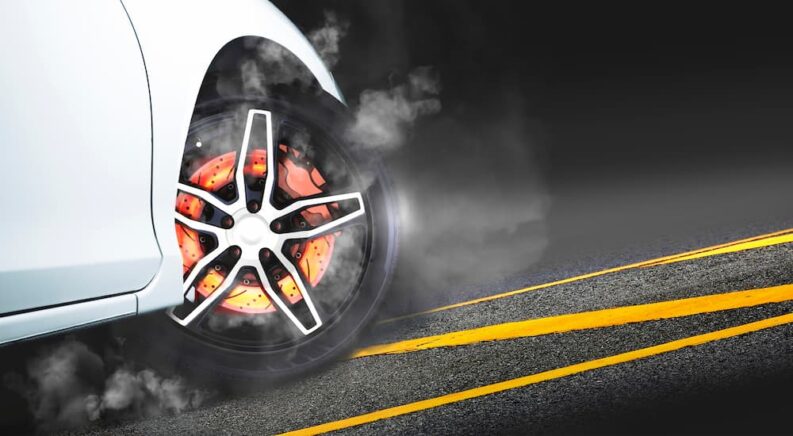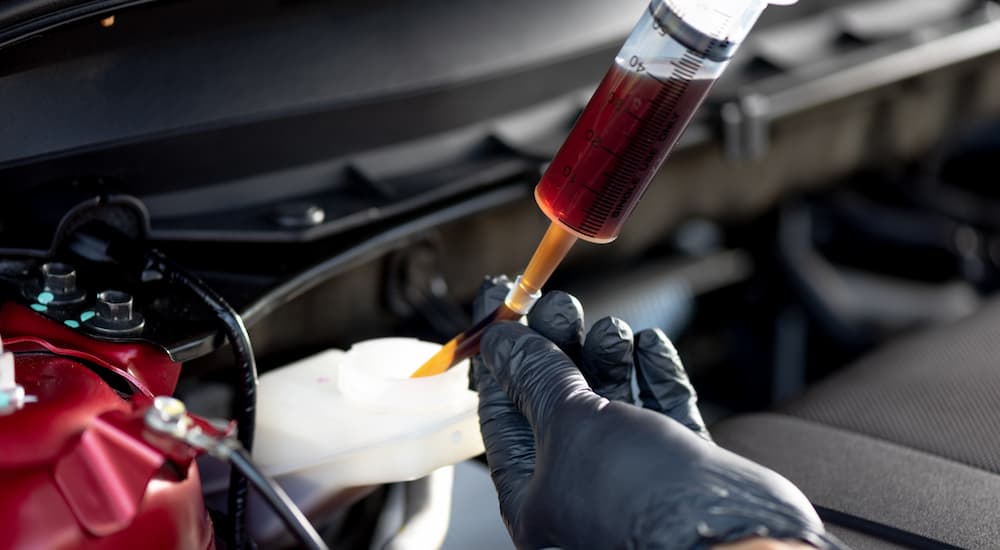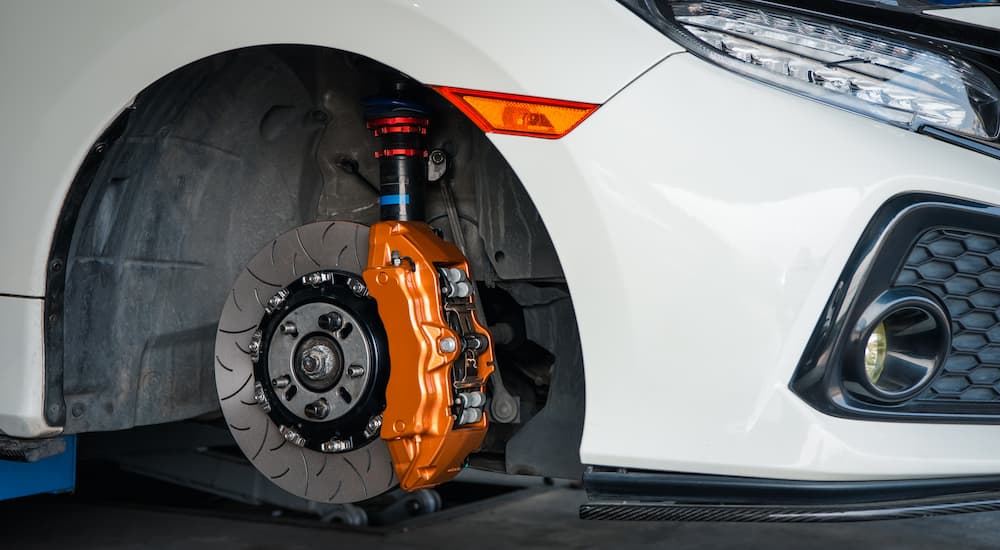While maybe not the most exciting upgrade you can do to your car, brakes are a vital ingredient in the mix to get faster track times. Being able to brake later when coming into a corner is a great way to get a cheeky overtake, and being able to go longer without experiencing brake fade makes sure that your performance doesn’t taper off after a few hot laps. So when you find your car is having a hard time coming to a stop as quickly as you’d like it to, what are the best steps to take to improve your braking performance? The first step is to make sure everything is working properly with regular brake service, but sometimes you need to upgrade. Should a big brake kit be your next step, or are there other more cost-effective ways to improve braking performance? That’s what I plan on going over today, and you might be surprised just how little is required to vastly improve your car’s ability to stop.
Brake Fluid
Many vehicles come from the factory with brake fluid that is not appropriate for high-performance driving; even some renowned performance cars like the new Toyota GR86 are known for coming with less-than-satisfactory brake fluid from the factory. This can lead owners to believe the braking system itself is in need of an upgrade when, instead, what is required is a simple fluid replacement.
When brake fluid is not up to spec, whether from low quality or age, it won’t stand up to the heat generated from braking. This is because not all brake fluids have the same boiling point, and the boiling point of brake fluid goes down as water makes its way into the braking system. Brake fluid is easily one of the most overlooked braking components despite its immense importance. A hallmark of your brake fluid not being up to spec is a squishy brake pedal that is easily compressed; some vehicles even have a warning light when the brake fluid needs to be replaced.
Higher-performance brake fluid has a higher boiling point than regular brake fluid. This is important because when the brake fluid boils, it becomes a gas and can no longer apply hydraulic pressure to the brakes. As water gets into the fluid over time, it progressively lowers the boiling point, which will make even good brake fluid less effective. So before you go and start replacing brake components, it may be worth it to try replacing the fluid with high-performance brake fluid to make sure that that wasn’t the problem. It could certainly save you some strain on the wallet.
Brake Pads
Calipers and rotors get most of the attention when it comes to brake upgrades, but the pads are just as important. The brake pads are what really provide the “bite” when braking as they are what contact the rotors and provide the friction to slow the car. While being one of the most important components, they also happen to be one of the most affordable components to replace. The three types of brake pads are organic, ceramic, metallic, and semi-metallic. For most performance applications, you would be best off going with a semi-metallic compound as they handle heat the best and provide the most bite. However, higher-performance pads can result in more noise, and the extra bite causes accelerated rotor wear and tear, so don’t go for a super aggressive pad if you plan on driving the car daily.
Brake Calipers
So, you’ve replaced your brake fluid and your brake pads with high-performance counterparts; perhaps you’ve even painted your stock calipers red, and even that is not enough to satisfy your needs. In that case, it’s probably time for you to look into upgrading your car’s calipers and rotors. Calipers are what provide the pressure that pushes the brake pads into your rotors. It doesn’t matter how good your brake pads are if they are not being pushed against the rotor hard enough to slow it down quickly.
The power that calipers can exert often comes down to the number of pistons that they have. However, there are also two main types of calipers used: fixed and floating. Floating calipers only have one piston on one side of the rotor that pushes the pads against the rotor. They are lightweight and relatively cheap but do not provide much when it comes to clamping pressure. Fixed calipers have pistons on both sides of the rotor that pinch the rotor between them when pressure is applied; they provide massive clamping pressure but tend to be more expensive than their floating counterparts. While floating calipers do not allow for multiple pistons, fixed calipers do, and that is why they are used for most performance setups. Fixed calipers generally have from two to eight pistons and provide both the best braking performance and feel compared to floating calipers.
Aftermarket calipers from high-performance brands can get extremely expensive, but fret not, as you may have options. Many calipers can work interchangeably between vehicles, so you may want to do some research into whether or not takeoffs from a higher-performance model will fit your vehicle as a way to save massive amounts of money. There are even companies that specialize in refurbished factory calipers with this specific purpose in mind. Just make sure you verify that you don’t need any extra parts in order to do the swap.
Brake Rotors
As far as brake rotors go, as long as you have vented rotors, you’re probably in good shape. You can tell if a rotor is vented if it has slots along the circumference of the rotor and is not just solid metal. The slots and the drilled holes you see on the face of the rotor are mostly for aesthetic purposes nowadays as outgassing, the problem that they were designed to solve, is not a problem with modern pads.
If, in your heart, that little kid playing Need For Speed Underground is crying for those cool-looking rotors, that’s okay. The heart wants what the heart wants, and truth be told, the slots and holes look cool. If you simply must have some sort of etching on the face of the rotor, I urge you to go with slots only. This is because drilled rotors not only heat up faster, but the drilled holes can actually cause cracks in the rotor when it heat cycles.
The most expensive “drilled” rotors are not actually drilled anymore but are instead cast with the holes already in place. This does help with the cracking problem, but they still heat up faster due to the missing mass. Slotted rotors, on the other hand, actually do provide the benefit of clearing out brake debris while still having the mass to stay cool longer. However, they do cause accelerated pad wear due to the uneven contact surface.
Stop at Your Own Pace
The right braking setup is different for every enthusiast, and what’s right for you may not be right for the next person. It’s all about what you’re willing to put in and what you’re trying to accomplish with your mods. The level of performance you need to make your car perform how you want may be as simple as swapping out the brake fluid, whereas someone else may need an entirely new braking system. This all depends on the use case you’re looking for; a dedicated track car and a weekend autocross warrior will likely desire different levels of performance. If you’re unsure of how much more performance you need, start from the bottom and work your way up. Or don’t—no one has ever said that their car stops too well.






